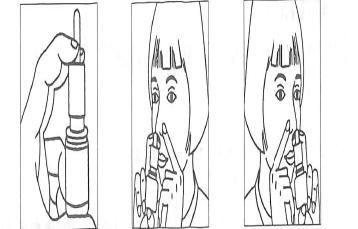
Nasopronal
Ask a doctor about a prescription for Nasopronal

How to use Nasopronal
Package Leaflet: Information for the User
Nasopronal, 50 micrograms/dose, nasal spray, suspension
Mometasone furoate
Read the package leaflet carefully before using the medicine, as it contains important information for the patient.
- Keep this leaflet, you may need to read it again.
- If you have any further questions, ask your doctor or pharmacist.
- This medicine has been prescribed for you only. Do not pass it on to others. It may harm them, even if their symptoms are the same as yours.
- If you experience any side effects, including those not listed in this leaflet, please tell your doctor or pharmacist. See section 4.
Contents of the package leaflet:
- 1. What is Nasopronal and what is it used for
- 2. Important information before using Nasopronal
- 3. How to use Nasopronal
- 4. Possible side effects
- 5. How to store Nasopronal
- 6. Contents of the pack and other information
1. What is Nasopronal and what is it used for
What is Nasopronal?
Nasopronal nasal spray contains mometasone furoate, which belongs to a group of medicines called corticosteroids.
Mometasone furoate administered intranasally relieves the symptoms of inflammation (swelling and irritation of the nasal mucosa), sneezing, itching, and a feeling of a blocked nose, and reduces the amount of nasal discharge.
What is Nasopronal used for?
Hay fever and perennial allergic rhinitis
Nasopronal is used to treat the symptoms of hay fever (also known as seasonal allergic rhinitis) and perennial allergic rhinitis in adults and children aged 6 years and older.
Hay fever, which occurs at certain times of the year, is an allergic reaction caused by inhaling pollen from trees, grasses, weeds, and mold spores.
Perennial allergic rhinitis occurs throughout the year, and the symptoms can be caused by sensitivity to various factors, including house dust mites, animal dander (or shed skin), feathers, and some foods. Nasopronal reduces the swelling and irritation of the nasal mucosa, thereby relieving sneezing, itching, a feeling of a blocked nose, or nasal discharge caused by hay fever or perennial allergic rhinitis.
Nasal polyps
Nasopronal is used to treat nasal polyps in adults aged 18 years and older.
Nasal polyps are small growths on the nasal mucosa, usually occurring in both nostrils.
Nasopronal reduces the inflammation in the nose, causing a gradual reduction in the size of the nasal polyps, thereby reducing the feeling of a blocked nose, which can make breathing difficult.
2. Important information before using Nasopronal
When not to use Nasopronal
Warnings and precautions
Before starting to use Nasopronal, you should discuss this with your doctor or pharmacist:
While using Nasopronal, you should discuss this with your doctor
If you experience blurred vision or other vision disturbances, you should contact your doctor.
If corticosteroids in the form of a nasal spray are taken in high doses for a long time, they may cause side effects due to the absorption of the medicine into the body.
If you experience itching or irritation of the eyes, your doctor may recommend other treatment with Nasopronal.
Children
If corticosteroids in the form of a nasal spray are taken in high doses for a long time, they may cause certain side effects, such as slowing down the growth rate in children.
It is recommended that the growth of children receiving long-term treatment with nasal corticosteroids be regularly monitored, and if any changes are observed, the doctor should be informed.
Nasopronal and other medicines
You should tell your doctor or pharmacist about all medicines you are taking, or have recently taken, and about any medicines you plan to take, including those available without a prescription.
If you are taking other corticosteroids orally or by injection to treat allergies, your doctor may recommend that you stop taking them when you start using Nasopronal. In some patients, after stopping oral or injected corticosteroids, side effects such as joint or muscle pain, weakness, and depression may occur. Other allergic symptoms, such as itching, tearing of the eyes, or red and itchy skin patches, may also appear. You should contact your doctor if you experience any of these symptoms.
Certain medicines may enhance the effect of Nasopronal, and your doctor may want to monitor your condition closely while you are taking such medicines (including certain medicines for HIV: ritonavir, cobicistat).
Pregnancy, breastfeeding
There are no data or only limited data available on the use of Nasopronal in pregnant women.
It is not known whether mometasone furoate passes into breast milk.
If you are pregnant or breastfeeding, think you may be pregnant, or plan to have a child, you should consult your doctor or pharmacist before using this medicine.
Driving and using machines
There are no data available on the effect of Nasopronal on the ability to drive or use machines.
Nasopronal contains benzalkonium chloride
The medicine contains 0.02 mg of benzalkonium chloride per dose.
Benzalkonium chloride may cause irritation or swelling inside the nose, especially if used for a long time.
3. How to use Nasopronal
Nasopronal should always be used as directed by your doctor. If you are unsure, you should consult your doctor or pharmacist.
The nasal spray should not be used more frequently, for a longer period, or in higher doses than recommended by your doctor.
Treatment of hay fever and perennial allergic rhinitis
Use in adults and children over 12 years of age
Usually, two doses of the nasal spray are used in each nostril once a day.
- After improvement, your doctor may recommend reducing the dose.
- If you do not feel better, you should contact your doctor, who may recommend increasing the dose: the maximum daily dose is four doses of the nasal spray in each nostril once a day.
Use in children aged 6 to 11 years
Usually, one dose of the nasal spray is used in each nostril once a day.
In some patients, relief of symptoms occurs within 12 hours of administration of the first dose of Nasopronal, but the full benefits of treatment may not be observed until after 2 days of treatment. It is very important that you use the nasal spray regularly to get the full benefits of treatment.
If you have severe symptoms of hay fever, your doctor may recommend starting to use Nasopronal a few days before the expected start of the pollen season. This will help prevent the symptoms of hay fever from occurring.
Nasal polyps
Use in adults over 18 years of age
Usually, two doses of the nasal spray are used in each nostril once a day.
- If after 5 to 6 weeks of treatment with the medicine, there is no improvement, your doctor may recommend increasing the dose to two doses of the nasal spray in each nostril twice a day.
After improvement, your doctor may recommend reducing the dose of the medicine.
- If after 5 to 6 weeks of treatment with the medicine twice a day, there is no improvement, you should contact your doctor.
Preparing the nasal spray for use
Nasopronal nasal spray contains a protective cap that protects the tip of the actuator and prevents it from becoming contaminated. Remember to remove it before using the spray and replace it after use.
Before using the spray for the first time, you should check that it works by pressing the pump 10 times until a fine mist is produced:
- 1. Gently shake the bottle.
- 2. Place your index and middle fingers on either side of the actuator and your thumb under the bottle. Do notpuncture the nasal spray actuator.
- 3. Pointing the actuator away from you, press your fingers together to spray the medicine 10 times until a fine mist is produced. If the nasal spray has not been used for 14 days or longer, you should press the pump 2 times until a fine mist is produced before using it again.
How to use the nasal spray

Figure 1
Figure 2
Figure 3
- 1. Shake the bottle gently and remove the protective cap. (Figure 1)
- 2. Gently blow your nose.
- 3. Close one nostril and insert the tip of the actuator into the other nostril, as shown in the figure. (Figure 2) Tilt your head slightly forward, keeping the bottle upright.
- 4. Start to breathe in gently and slowly through your nose, while spraying the medicine (in the form of a fine mist) into your nose, pressing the pump ONCEwith your fingers.
- 5. Breathe out through your mouth. Repeat the steps described in point 4 to administer a second dose of the nasal spray to the same nostril, if necessary.
- 6. Remove the tip of the actuator from your nostril and breathe out through your mouth.
- 7. Repeat the steps described in points 3 to 6 to administer the nasal spray to the other nostril. (Figure 3)
After using the nasal spray, you should carefully wipe the tip of the actuator with a clean tissue or cloth and replace the protective cap.
Cleaning
- It is important to regularly clean the nasal spray bottle, as otherwise, it may not work properly.
- Remove the protective cap and gently pull off the actuator.
- Wash the actuator and protective cap in warm water, then rinse under running water.
Do not unblock the actuator by piercing it with a needle or other sharp object, as this will damage the actuator and the correct dose of the medicine will not be delivered.
- Leave the protective cap and actuator in a warm place to dry.
- Replace the actuator on the bottle, then put on the protective cap.
- After cleaning, check that the actuator is working properly and spray the medicine 2 times.
Using a higher dose of Nasopronal than recommended
If you accidentally use a higher dose of the medicine than recommended, you should contact your doctor.
If corticosteroids are used for a long period or in high doses, they may have an adverse effect on your hormones. In children, they may affect growth and development.
Missing a dose of Nasopronal
If you forget to use the nasal spray at the right time, you should use it as soon as you remember, and then continue with your regular treatment schedule.
Do not use a double dose to make up for a forgotten dose.
Stopping treatment with Nasopronal
In some patients, relief of symptoms occurs within 12 hours of administration of the first dose of Nasopronal, but the full benefits of treatment may not be observed until after 2 days of treatment. It is very important that you use the nasal spray regularly. You should not stop treatment, even if you feel better, unless your doctor recommends it.
If you have any further questions about the use of this medicine, you should ask your doctor or pharmacist.
4. Possible side effects
Like all medicines, Nasopronal can cause side effects, although not everybody gets them.
After using this medicine, immediate allergic reactions (hypersensitivity) may occur. These reactions can be severe. You should stop using Nasopronal and seek medical help immediately if you experience symptoms such as:
- swelling of the face, tongue, or throat
- difficulty swallowing
- hives
- wheezing or difficulty breathing.
If corticosteroids in the form of a nasal spray are taken in high doses for a long time, side effects may occur due to the absorption of the medicine into the body.
Other side effects
Most people using nasal sprays do not experience any side effects. However, in some people, after using Nasopronal or another corticosteroid nasal spray, the following side effects have occurred:
Common side effects (may affect up to 1 in 10 people):
- headache
- sneezing
- nasal bleeding [very common (may affect more than 1 in 10 people) in patients with nasal polyps who used two doses of Nasopronal in each nostril twice a day]
- burning sensation in the nose
- irritated nose or sore throat
- ulceration of the nasal mucosa
- upper respiratory tract infection.
Frequency not known (frequency cannot be estimated from the available data):
- increased intraocular pressure (glaucoma) and/or cataracts causing vision disturbances
- blurred vision
- damage to the nasal septum
- disturbances of taste and smell
- difficulty breathing and/or wheezing.
Reporting side effects
If you experience any side effects, including those not listed in this leaflet, you should tell your doctor or pharmacist. You can also report side effects directly to the Department of Drug Safety Monitoring, Office for Registration of Medicinal Products, Medical Devices, and Biocidal Products, Al. Jerozolimskie 181C, 02-222 Warsaw, tel.: +48 22 49 21 301, fax: +48 22 49 21 309, e-mail: [email protected]
Side effects can also be reported to the marketing authorization holder.
By reporting side effects, you can help provide more information on the safety of this medicine.
5. How to store Nasopronal
Do not freeze.
The shelf life after first opening is 2 months.
Keep the medicine out of the sight and reach of children.
Do not use this medicine after the expiry date stated on the bottle and carton after EXP.
The expiry date refers to the last day of the month.
Medicines should not be disposed of via wastewater or household waste. You should ask your pharmacist how to dispose of medicines that are no longer required. This will help protect the environment.
6. Contents of the pack and other information
What Nasopronal contains
- The active substance of the medicine is mometasone furoate. Each dose contains 50 micrograms of mometasone furoate in the form of a monohydrate.
- The other ingredients are: glycerol, microcrystalline cellulose, and sodium carmellose, sodium citrate, citric acid monohydrate, benzalkonium chloride (see section 2 for further information), polysorbate 80, purified water.
What Nasopronal looks like and contents of the pack
Nasopronal is a nasal spray, in the form of a white or almost white, opaque suspension, packaged in an HDPE bottle with a dosing pump and a polypropylene applicator with a protective cap, in a cardboard box.
Pack sizes:
- bottle containing 10 g of nasal spray, suspension - 60 doses
- bottle containing 18 g of nasal spray, suspension - 140 doses.
Marketing authorization holder and manufacturer:
Marketing authorization holder:
Vitama S.A.
Bonifraterska 17 Street
00-203 Warsaw
Manufacturer:
MIPHARM S.p.A.
Via Quaranta 12,
20141 Milan
Italy
Date of last revision of the leaflet:
- Country of registration
- Active substance
- Prescription requiredYes
- Manufacturer
- ImporterMipharm S.p.A.
- This information is for reference only and does not constitute medical advice. Always consult a licensed doctor before taking any medication. Oladoctor is not responsible for medical decisions based on this content.
- Alternatives to NasopronalDosage form: Aerosol, 50 mcg/doseActive substance: mometasoneManufacturer: FARMEA US Pharmacia Sp. z o.o.Prescription not requiredDosage form: Aerosol, 50 mcg/doseActive substance: mometasoneManufacturer: FarmeaPrescription requiredDosage form: Aerosol, 50 mcg/doseActive substance: mometasoneManufacturer: Adamed Pharma S.A. FarmeaPrescription not required
Alternatives to Nasopronal in other countries
The best alternatives with the same active ingredient and therapeutic effect.
Alternative to Nasopronal in Spain
Alternative to Nasopronal in Ukraine
Online doctors for Nasopronal
Discuss dosage, side effects, interactions, contraindications, and prescription renewal for Nasopronal – subject to medical assessment and local rules.








